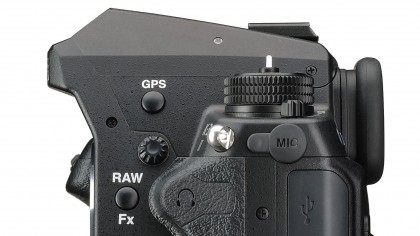Pentax K-3 II joins the movers and shakers with its own high-resolution sensor shift mode
The underdog DSLR maker now has something that Nikon and Canon don't have

The Pentax K-3 II is not just another DSLR. Pentax has always produced interesting, quirky cameras just that little bit different to Canon and Nikon DSLRs – for many folk, just a little too different. But the K-3 II is something new.
It's the third new Pentax DSLR since last August. It started with the K-S1, a decent little camera for beginners and fashionistas if you don't mind the flashing lights and offbeat controls. Then came the K-S2, a much more traditional, tough and powerful DSLR for family use, according to Pentax, but with clear appeal for enthusiasts too.

But now Pentax has surprised everyone (well us, anyway) with a new flagship DSLR that uses the same idea as the rather brilliant Olympus OM-D E-M5 II. It combines a series of images shot in close succession with just a one-pixel shift between them to produce high-resolution images of a quality you can't get from a regular single-layer sensor.
Read: Pentax K-3 review, Pentax K-S1 review, Pentax K-S2 review, Olympus OM-D E-M5 II review
Shifting paradigms
Once upon a time, camera makers used sensor-shift technologies simply as an alternative to lens-based image stabilizers. The camera has gyroscopic sensors to detect the tiniest camera movement during the exposure and instantly compensate by shifting the sensor to counteract it.
This sensor-shift system is also used to vibrate the sensor at very high frequencies to shake off any dust particles. But then when you've got this fast, precise sensor shifting technology, does it have to stop there?
There are two main limitations to mainstream sensor technology. The first is that the resolution is limited by the number of pixels you've got on the sensor, and the second is that each one is sensitive to only red, green or blue light and the camera has to interpolate (guess at) the full colour data for a pixel by using the data from those around it.
Sign up for breaking news, reviews, opinion, top tech deals, and more.

But if you shift the sensor minutely, a pixel at a time, for a series of image captured during a single exposure, you overcome both limitations. You can capture 'in-between' pixels to add resolution – this is what the Olympus OM-D E-M5 II does with half-pixel shifts. And you can shift the sensor a pixel at a time to capture full-colour data (real, not interpolated) for each pixel.
Details are scant at the moment, and it's not yet clear whether the Pentax K-3 II offers a high-resolution mode, or whether it simply records 'better' 24-megapixel images, its sensor's native resolution. What Pentax does say is that this mode produces more detail, better colour and lower noise.
It's also not clear whether it will have the same limitations as Olympus's system – the need for a static subject and a tripod.
More on this just as soon as we have it.
What else is new?
This is by no means the only interesting feature in the K-3 II, though in most respects it's identical to its predecessor, the K-3. It's a tough, hardy camera with a stainless steel chassis and magnesium alloy body, and it's weatherproof and dustproof – with no fewer than 92 seals – and coldproof down to -10 degrees centigrade.
Like its predecessor, it has a 24-megapixel APS-C sensor with no anti-aliasing filter, and this is done to provide maximum sharpness. The even more clever part is that it has an anti-aliasing simulator which uses tiny sensor movements (that sensor-shift system again!) to prevent moiré effects with fine patterns or textures.

The continuous shooting speed stays the same as the K-3's, at 8.3 frames per second, and it's maintained for 23 raw files or 60 JPEGs. Both cameras have twin SD card slots, the same body-only weight of 700g (25.2oz), 720-shot battery life and 27-point SAFOX 11 autofocus system.
But the K-3 II adds in-built GPS, which can record location, latitude, longitude, altitude, UTC (universal time corrected) and direction, using an electronic compass.
Pentax says it has improved the SR (shake reduction) system too, and it now offers up to 4.5 stops of compensation.
Pricing and availability
We were impressed with the Pentax K-3, and we can't wait to try out the K-3 II's high-resolution mode to see how effective it really is. If this technology takes off, it could spell the end for the current megapixel/sensor size race and see sensor technology heading off in new and unexpected directions.

The Pentax K-3 II goes on sale on May 22 2015. It will cost £769.99 body only (about US$1150/AU$1490), £849.99 (about US$1270/AU$1640) with the Pentax 18-55mm WR kit lens or £1,149 (about US$1720/AU$2220) with the new Pentax 16-85mm WR lens.

Rod is an independent photographer and photography journalist with more than 30 years' experience. He's previously worked as Head of Testing for Future’s photography magazines, including Digital Camera, N-Photo, PhotoPlus, Professional Photography, Photography Week and Practical Photoshop, and as Reviews Editor on Digital Camera World.